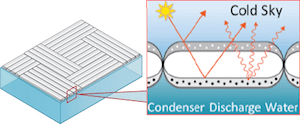More than 86 percent of the electricity used in the United States today is generated by thermoelectric power plants, which operate by boiling water to create steam that is used to spin turbines for generating electricity. Yet about 60 percent of that energy is wasted as it is converted to low-grade heat that must be carried away by condenser-based cooling systems. The most popular method used by power plants to remove this heat is through wet-cooling, which uses water from nearby rivers, lakes, or the ocean to cool the power plant’s condenser water and then return the water to its source.
According to the United States Geological Survey, 41 percent of all fresh water withdrawals in the U.S. are attributed to wet-cooling systems at power plants. But as water resources are increasingly strained by growing demand, drought, and even changing global temperature cycles, new methods must be developed to efficiently cool condenser water without negatively impacting the nation’s water supplies.

To address this challenge, the U.S. Department of Energy’s Advanced Research Projects Agency-Energy (ARPA-E) Advanced Research in Dry cooling (ARID) program is exploring novel ways to use air-cooled heat exchangers and supplemental cooling systems to carry away waste heat in thermoelectric power generation. SRI International and PPG Industries Inc. are collaborating to integrate SRI’s proprietary Spectrally Tuned All-Polymer Technology for Inducing Cooling (STATIC) technology into a low-cost radiative cooling system and water cover that can cool water during the day or at night without evaporation.
Dry-cooling systems, which use air instead of water to remove heat, are in limited use today because the current technology is expensive and uses more energy than wet-cooling systems, thereby reducing the power plant’s efficiency. Together, SRI and PPG are addressing the use of radiative cooling in a unique approach that is aimed at paving the way for broader adoption of dry-cooling systems.
The STATIC system is constructed almost completely out of low-cost polymers that form a two-layer polymer structure—similar to a floating pool cover—that sits on top of a thermoelectric power plant’s water discharge ponds. The structure effectively seals a body of water, acting like a filter between the hot water and the cool atmosphere, allowing cooling to occur with no evaporation. In addition, the structure does not require any power input to achieve cooling.
The structure’s all-polymer top layer STATIC film prevents sunlight from penetrating the structure and warming the water, while allowing thermal energy to radiate to the sky. The bottom layer acts an emitter at the water level and radiates the heat in the water up to the sky through the top layer that transmits the thermal radiation. Both layers work together to reject solar energy, while the air between the two layers acts as insulation, preventing conductive and convective heating. The system is designed to work both day and night—allowing for cooling even when the air temperature is greater than that of the water.
By working with ARPA-E, we’re focused on developing technologies that address future issues, such as potential water shortages that could impact thermoelectric power plants’ ability to operate with wet-cooling systems. If successful, SRI’s technology combined with PPG’s manufacturing and marketing expertise, could provide power plant operators an inexpensive means of supplemental cooling while achieving efficient power plant performance for U.S. electric power generation.
The information, data or work presented herein was funded in part by the Advanced Research Projects Agency-Energy (ARPA-E), U.S. Department of Energy, under Award Number DE-aR0000576. The views and opinions of authors expressed herein do not necessarily state or reflect those of the United States Government or any agency thereof.



